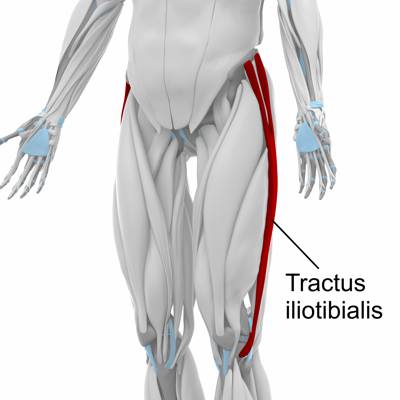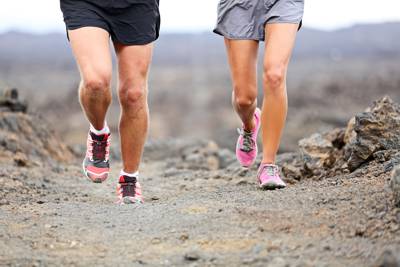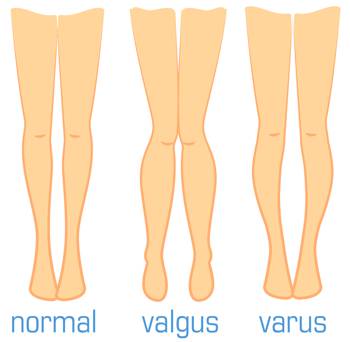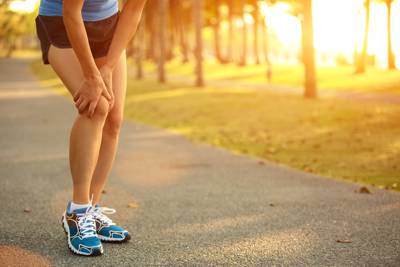Iliotibial band syndrome
Synonyms: ITBS, runner’s knee
Table of contents
- Function of the iliotibial tract
- What is the iliotibial band syndrome?
- Causes of iliotibial band syndrome
- Symptoms of iliotibial band syndrome
- Diagnosis of iliotibial band syndrome
- Diseases with similar symptoms (differential diagnoses)
- Therapy of iliotibial band syndrome
- Rehabilitation and prevention of runner's knee
Function of the iliotibial tract
The tractus iliotibialis is a tendon fibre cord that is part of our musculoskeletal system and is partly responsible for enabling us to walk and run. It is formed from the tendon fibres of various muscles and extends away from the hip, down along the outside of the thigh to the lateral head of the tibia. The tract is a reinforcement of the femoral fascia (fascia lata). The weight of the body causes the femur to bend outwards when standing upright: the lateral tension belt through the iliotibial tract reduces the bending stress on the bone (tension belt principle).

What is the iliotibial band syndrome?
This refers to pain in the knee area that originates from the iliotibial tract due to overuse. It may be that the slightest movement causes friction on the tendon and muscle when the femur, over which the tract passes, protrudes. When there is little movement, the affected person often does not notice this. However, when repeated movements are carried out or when there is permanent overloading, increased friction occurs. This leads to inflammation of the overstrained tissue and consequently to the symptoms of iliotibial band syndrome mentioned above.

Causes of iliotibialband syndrome
- Overload: intensive running causes increased friction in the area of the iliotibial tract.
- Incorrect loading: an incorrect running style leads to increased friction in the knee despite normal anatomy.
- Malalignment of the leg axis: as there is increased tension on the outer side of the leg, especially in bow legs (varus), this ultimately leads to greater susceptibility to irritation
- Foot deformities: Flat foot and splay foot
- Shortened musculature causes the tractus iliotibialis to be under increased traction
- Unsuitable footwear

Symptoms of iliotibial band syndrome
Both running and walking can be affected by severe, load-related pain. This pain is usually localised in the knee area or on the outside of the knee, but it can also radiate. It is described as stabbing, cutting or pulling. In addition, there may be a pressure pain over the outside of the knee. The intensity of the pain depends on the progress of the iliotibial band syndrome, i.e. if iliotibial band syndrome has been present for a long time, pain can also occur at rest. When running, it is typical that the pain occurs after a certain distance has been covered: up to a certain point, the rubbing is tolerated, after which the pain begins, which only disappears by stopping running.

in the area of the tractus iliotibialis
Diagnosis of iliotibial band syndrome
Clinical diagnostics
A detailed discussion (anamnesis) about the existing symptoms is important for the diagnosis. During the patient interview, the typical pain localisation of iliotibial band syndrome is on the outside of the knee during/after running (or sport in general). This is followed by a physical examination. The knee joint and the musculature are examined and assessed. The doctor feels the tendon or muscle plate above the knee: if this causes the corresponding pain, this indicates iliotibial band syndrome.
Diagnostic imaging
In most cases, imaging is not absolutely necessary if the classic symptoms of iliotibial band syndrome occur and the complaints are related to running. Ultrasound, X-ray and MRI are used to rule out other diseases with similar symptoms (differential diagnoses). They are also used in case of non-response to therapy.
Diseases with similar symptoms (differential diagnoses)
In most cases, the diagnosis of runner's knee is very clear on the basis of the medical history and the clinical examination. However, there are other orthopaedic diseases that can have similar symptoms:
- Injury to the outer meniscus
- Cartilage defect in the outer joint compartment
- Valgus gonarthrosis (joint wear in the outer joint compartment)
- Coxarthrosis (Osteoarthritis of the hip)
Hip pain in the context of hip osteoarthritis very often radiates to the outside of the knee. - Fatigue fracture
In contrast to the acute bone fracture, the force is too low for a spontaneous bone fracture: The fatigue fracture or fatigue fracture occurs due to a permanent overload of the bone that develops over a longer period of time. A distinction can be made here between stress fracture and insufficiency fracture. A stress fracture can develop in a healthy person due to permanent overloading, which occurs in most cases in competitive athletes. In the case of an insufficiency fracture, the development is due to a permanent overload of diseased bones (e.g. the bone is porous due to osteoporosis). - Muscle fibre tears
- Injuries to a tendon
Therapy of iliotibial band syndrome
Conservative therapy
In the longer term, it is important to treat the cause of iliotibial band syndrome - not just the symptoms themselves. In principle, the athlete's running style and running shoes should be checked. With suitable running shoes and insoles, one can compensate for possible misalignments of the leg axis or foot. Often runners have shortened muscles on the outside of the hip (abductors). Daily stretching of this muscle group can contribute a lot to the recovery and also prevention of iliotibial band syndrome. In addition, targeted physiotherapy can help. Normally, iliotibial band syndrome can be treated well with conservative therapy, i.e. without surgery. This consists of physical rest, with the reduction or suspension of running as the top priority. During this time, however, there is nothing to be said against sports such as cycling or swimming (crawl!). In addition, the knee can be cooled and elevated, and anti-inflammatory ointments or plasters can be applied. In the further course, pain-relieving medication can be a support. The duration of treatment for iliotibial band syndrome depends on the progress of the inflammation. It usually takes about six to eight weeks to heal. If you take it easy from the beginning, the pain can disappear within days to weeks. However, if the pain is ignored and passed over by exercise, it becomes more severe and so does the inflammation. If discomfort is still present despite rest and pain medication, an injection of cortisone (an anti-inflammatory preparation that is locally effective) can be given.
Surgical therapy
In the event that the conservative treatment of iliotibial band syndrome described above does not lead to sufficient improvement, an attempt is made to eliminate the cause of the pain surgically. If there is a narrowing of the knee (caused by the protruding bony prominence), this can be surgically removed. This should make it possible for the muscle movements to take place unhindered again and there is no more friction and consequently no more pain. If the tractus iliotibialis is shortened, it can be cut during an operation. This lengthens it. If the complaints are caused by a malposition (e.g. bow legs), this can also be corrected surgically if it is serious and the cause of the complaints can thus be eliminated.
Rehabilitation and prevention of iliotibial band syndrome
Approximately two weeks after the pain has subsided, it is possible to resume casual sports. The most important thing is to approach it slowly and carefully so that you can counteract renewed overloading and/or incorrect loading. This means slowly increasing the load and training sessions. Stretching the muscles before and after the activity is important as an accompaniment to the therapy and also as a preventive measure. Stretching is mainly done on the outside of the leg, where the tractus iliotibialis is located. As mentioned above, a correct running style with the right running shoes also helps.